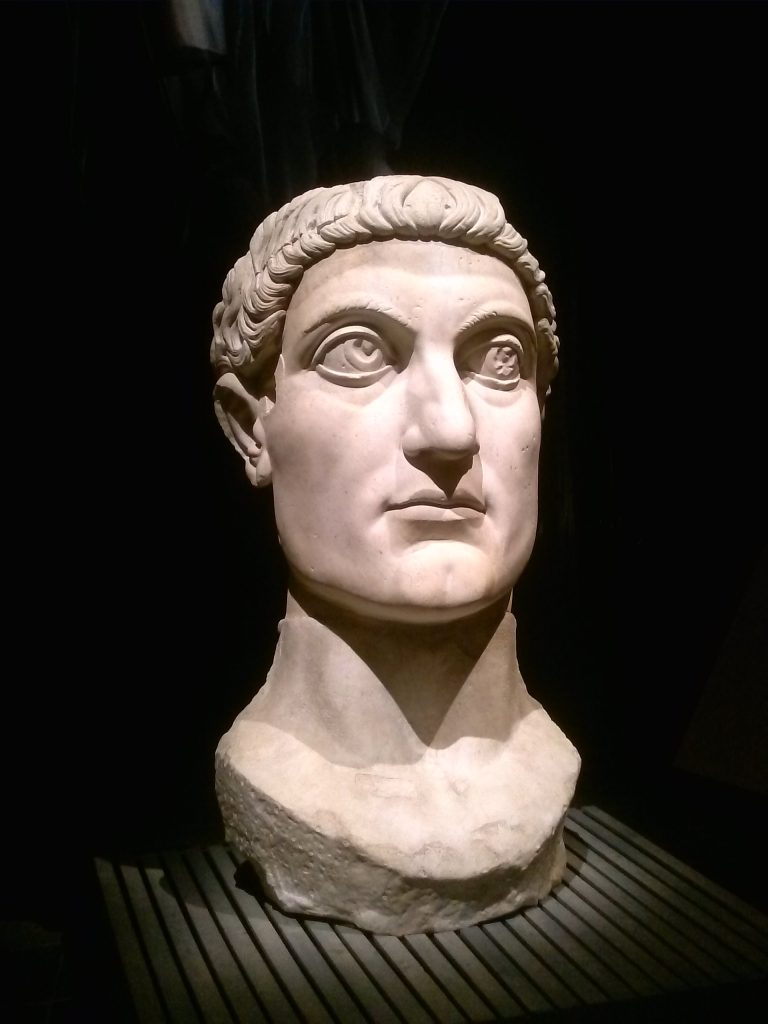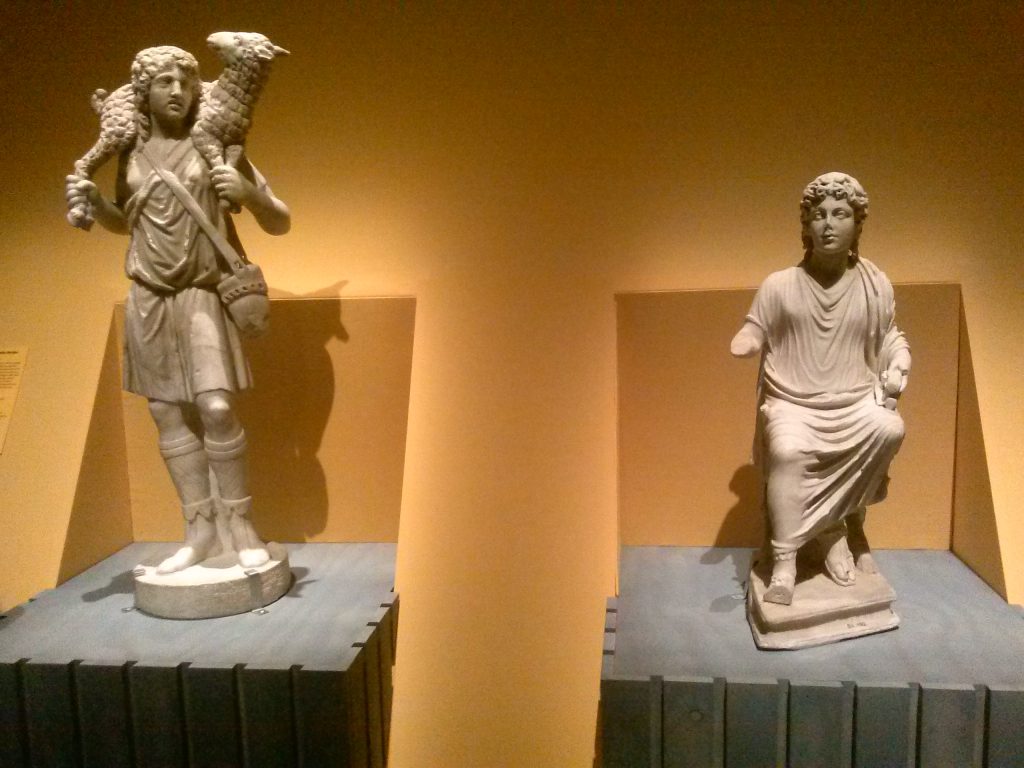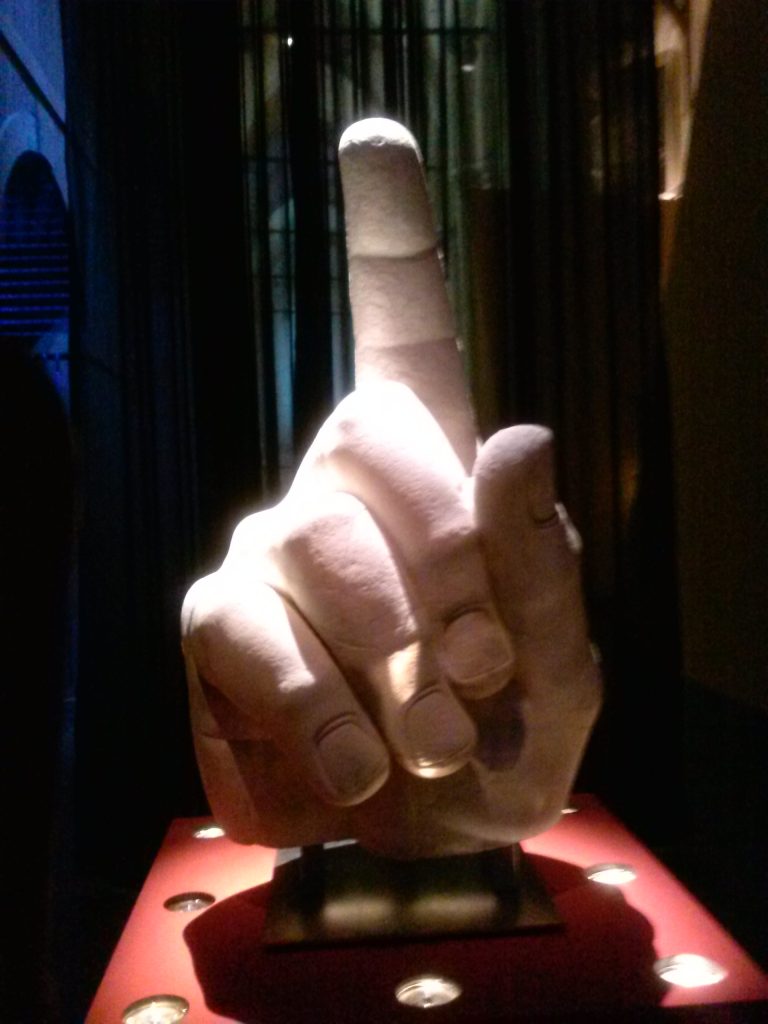The man with the firm jaws and vacant, upward-looking eyes is not particularly attractive. His face does appear on all the posters around town. However, it is something other than this robust stone head against the black background that triggers you, on the poster of the exhibition at the Nieuwe Kerk in Amsterdam. That is the tilted O of the word Rome. ''Rome. The dream of Emperor Constantine'' is the name of the exhibition. And that tilted letter symbolises the tipping point in history that this exhibition is about.

Here in the New Church, the story is told of Emperor Constantine, who gave Christianity all the space it needed in the fourth century. Thanks to him, the imperial capital full of temples of Roman gods becomes the papal centre of the world. Churches are built and Christians are given the opportunity to practice their faith openly. The story of this turn of events is told through dozens of ancient Roman and early Christian treasures, never before seen in the Netherlands.
Triumphal Arch
The exhibition feels like a walk through ancient Rome.Because it is like stepping into Rome and experiencing a play in five acts. You walk under a triumphal arch and the first thing you see (or think you see) is a huge statue of Emperor Constantine. At least this is how imposing (because 12 metres high) his statue must have once looked. What is left of it, a head, a foot and a hand, stands in Rome. A copy is now on display in the New Church. This head is half the actual size. Here, in part 1 of the exhibition, Rosita Steenbeek, our Dutch woman in Rome, takes you by the hand like a city guide. It seems to be a tolerant, multi-religious society in this early fourth century, but Christianity is not yet accepted. It is the emperor who is worshipped and who tolerates no competition.
Unknown woman
 In the audio tour, Rosita Steenbeek pleasantly explains what the sarcophagi, mosaics and a marble bust of an ''unknown woman'' on display here depict. Guest curator Eric Moorman (professor of Classical Archaeology in Nijmegen) points out what a magnificent piece of art has been brought here: this unknown woman is a one-piece sculpture, but the head is made of white marble, while in her clothing you can actually see the veins of the marble, as if it had been used as a design for the blouse. The second guest curator, Professor of Early Christian Art and Architecture Sible de Blaauw (also from Radboud University), thinks it is wonderful to see at this exhibition - for the first time! - to see two statues side by side, which are in Rome in two different museums. For him, the highlight of the exhibition are that ''Image of a Sheepbearer/Good Shepherd'' and ''Image of a Teacher/Learning Christ'' - are here side by side. For him, they are two of the most iconic representations of Christ. Images that may have originally represented something else, but Christ as shepherd and as teacher later became quintessentially Christian.
In the audio tour, Rosita Steenbeek pleasantly explains what the sarcophagi, mosaics and a marble bust of an ''unknown woman'' on display here depict. Guest curator Eric Moorman (professor of Classical Archaeology in Nijmegen) points out what a magnificent piece of art has been brought here: this unknown woman is a one-piece sculpture, but the head is made of white marble, while in her clothing you can actually see the veins of the marble, as if it had been used as a design for the blouse. The second guest curator, Professor of Early Christian Art and Architecture Sible de Blaauw (also from Radboud University), thinks it is wonderful to see at this exhibition - for the first time! - to see two statues side by side, which are in Rome in two different museums. For him, the highlight of the exhibition are that ''Image of a Sheepbearer/Good Shepherd'' and ''Image of a Teacher/Learning Christ'' - are here side by side. For him, they are two of the most iconic representations of Christ. Images that may have originally represented something else, but Christ as shepherd and as teacher later became quintessentially Christian.

Catacombs
In part two of the exhibition, city guide number 2, Rome expert Antoine Bodar, takes us through Rome's catacombs. For Christianity was still living underground in the early fourth century. The Roman gods of yore are already losing popularity: traditional themes and Christian scenes are already juxtaposed on the sarcophagi. The cross as a sign of victory also appears for the first time.
Vision
That cross on which Jesus Christ died played an important role in the upheaval that took place in the fourth century. Emperor Constantine, in fact, had a dream. A vision. In it, he saw a shining cross and was assured that he would have God's support in the battle. And Emperor Constantine did indeed subsequently defeat his rival Maxentius at the Battle of the Milvian Bridge in 312.
This prompted Constantine to introduce freedom of religion and openly adhere to Christianity. He then immediately had monumental churches built. This story is depicted in Room 3, where huge copies of frescoes from the Vatican Museum hang. The vision, battle and triumph of Christianity are depicted on huge canvases. And here, moreover, lies a precious cameo, the largest in classical antiquity. The story of Emperor Constantine's triumph is worked in agate.
In the last room of the exhibition, parts 4 and 5 intertwine. In part 4, Sible de Blaauw tells how the church gains influence in Rome and how Rome becomes the capital of the world. Churches are lavishly decorated thanks to Constantine, and these churches of late antiquity are still landmark buildings in Rome.
The exhibition concludes with paintings depicting early Christianity. City guide Nelleke van der Krogt, the latest Rome expert, talks about Il Veronesi's beautiful painting, ''The Vision of Saint Helena''. He painted the mother of Emperor Constantine, who also receives a vision with a cross.
Firm hand

The enormous hand of Constantine, pointing his finger upwards, marks the end of the exhibition. That image can symbolise all sorts of things, according to what the city guides say about it in conclusion. According to Rosita Steenbeek, you can see in it the firm hand Constantine had in Christianity. For Eric Moorman, he symbolises pretensions and world changes. He changed the world's view of Rome, which from then on became a Christian city. The hand symbolises worldly power, while also pointing to heaven. Sible de Blaauw sees how Constantine had a hand in the creation of Europe. Nelleke de Krogt sees it as the great influence on Western culture. And Antoine Bodar adds, bringing us back to our own time: ''Christianity was promoted in the time of Constantine. And now we have arrived in 2015, in the Low Countries. Here we are in a church, which has been cleared to host an exhibition.''
Rome. Emperor Constantine's dream'' at the Nieuwe Kerk, Amsterdam. From 3 October to 7 February 2016. More info: www.nieuwekerk.nl
The exhibition will be accompanied by the catalogue of the same name, written by Eric Moorman and Sible de Blaauw. Price €19.95. Rosita Steenbeek wrote her first children's book especially for the exhibition: ''De triomfboog''. Price €12.95.
